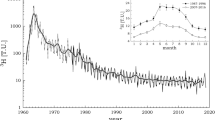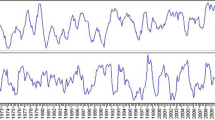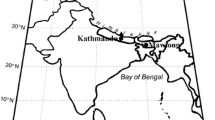Abstract
The series of δ18O values is presented for all precipitation events in Moscow in 2014. Precipitation samples were taken at the observation site of the Meteorological Observatory of Lomonosov Moscow State University (MSU MO), and the isotopic analysis was carried out in the isotopic laboratory of the Department of Geography of MSU. The concentration of stable 18O in precipitation over Moscow in 2014 varied from -0.09 to -26.29‰. The maximum amplitudes of δ18O were registered in March-April and October. The pronounced interrelation was revealed between the oxygen isotopic composition of precipitation and surface air temperature (the correlation coefficient is 0.85). The computation of back trajectories of air masses and the analysis of weather charts demonstrated that the most isotopically light precipitation is typical of relatively cold air masses slowly moving over the continent during the last five days before precipitation. In this case, the ongoing condensation leads to the progressive isotopic depletion of precipitation (more and more isotope-depleted precipitation is registered). On the contrary, fast air transport from the middle and even from high latitudes of the Atlantic Ocean leads to the relatively constant of δ18O values of precipitation.
Similar content being viewed by others
References
V. S. Brezgunov, A. D. Esikov, T. V. Yakimova, et al., “Distribution of Average Annual Concentration of 180 in Precipitation in the European part of Russia,” Materialy Meteorologicheskikh Issledovanii, No. 12 (1987) [in Russian].
Yu. K. Vasil’chuk, N. A. Budantseva, A. C. Vasil’chuk, and Ju. N. Chizhova, Isotope Rations in Environment, Part 3: Atmosphere and Hydrosphere (MGU, Moscow, 2013) [in Russian].
V. E. Vetshtein, Isotopes of Oxygen and Hydrogen in the Natural Waters of the USSR (Nedra, Leningrad, 1982) [in Russian].
Ju. N. Chizhova, N. A. Budantseva, L. E. Efimova, et al., “Oxygen Isotopic Composition of Precipitation and Water in the Middle Protva River System,” Vestnik Moskovskogo Un-ta. Seriya 5. Geografiya, No. 2 (2013) [in Russian].
V. I. Ferronskii and V. A. Polyakov, Isotopy of the Earth Hydrosphere (Nauchnyi Mir, Moscow, 2009) [in Russian].
J. Crawford, C. E. Hughes, and S. D. Parkes, “Is the Isotopic Composition of Event Based Precipitation Driven by Moisture Source or Synoptic Scale Weather in the Sydney Basin, Australia?”, J. Hydrol., 507 (2013).
W. Dansgaard, “Stable Isotopes in Precipitation,” Tellus, No. 4, 16 (1964).
W. G. Darling and J. C. Talbot, “The O & H Stable Isotopic Composition of Fresh Waters in the British Isles. 1. Rainfall,” Hydrol. and Earth System Sci., No. 2, 7 (2003).
R. R. Draxler and G. D. Rolph, HYSPLIT (HYbrid Single-Particle Lagrangian Integrated Trajectory) Model Access via NOAA ARL READY Website (NOAA Air Resources Laboratory, Silver Spring, MD, 2011); http://ready.arl.noaa.gov/HYSPLIT.php.
W. G. Mook, Environmental Isotopes in the Hydrological Cycle. Principles and Applications, Vol. III, No. 39. Surface Water (UNESCO, Paris, 2001).
G. D. Rolph, Real-time Environmental Applications and Display System (READY) Website (NOAA Air Resources Laboratory, Silver Spring, MD, 2011); http://ready.arl.noaa.gov.
G. Vodila, L. Palcsu, I. Futo, and Zs. Szanto, “Implications on Isotope Hydrology and Regional Palaeoclimatology,” J. Hydrol., 400 (2011).
Y. Yurtsever, Worldwide Survey of Isotopes in Precipitation, IAEA Report (Vienna, 1975).
Y. Yurtsever and J. R. Gat, “Atmospheric Waters,” in Stable Isotope Hydrology: Deuterium and Oxygen-18 in the Water Cycle, Ed. by J. R. Gat and R. Gonfiantini, Technical Report Series, 210 (1981).
Author information
Authors and Affiliations
Corresponding author
Additional information
Original Russian Text © Ju.N. Chizhova, I.D. Eremina, N.A. Budantseva, G.V. Surkova, Yu.K. Vasil’chuk, 2017, published in Meteorologiya i Gidrologiya, 2017, No. 1, pp. 78-90.
About this article
Cite this article
Chizhova, J.N., Eremina, I.D., Budantseva, N.A. et al. Concentration of 18O in precipitation over Moscow in 2014. Russ. Meteorol. Hydrol. 42, 54–63 (2017). https://doi.org/10.3103/S1068373917010071
Received:
Published:
Issue Date:
DOI: https://doi.org/10.3103/S1068373917010071




